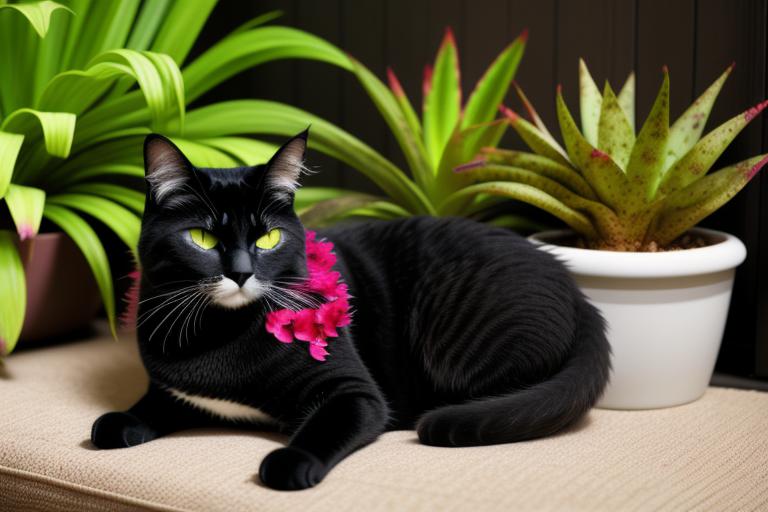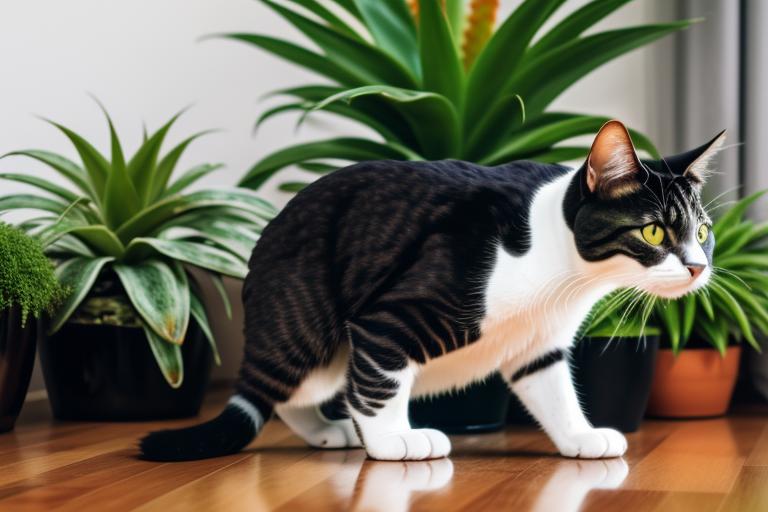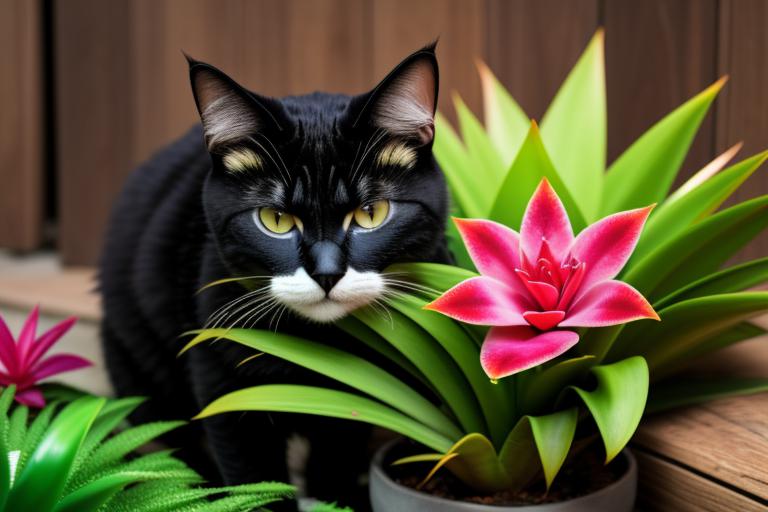Have you ever wondered if those beautiful bromeliads you have in your home could potentially harm your beloved feline companion? While these tropical plants can add a touch of vibrant color to your living space, it’s important to be aware of their potential toxicity to cats.
But fear not, because in this discussion, we will explore the facts and offer essential information that will help you ensure the safety and well-being of your furry friend. So, without further ado, let’s uncover the truth about bromeliads and their potential impact on our curious and mischievous feline friends.
Signs of Bromeliad Toxicity in Cats
If your cat has been exposed to bromeliads, it’s important to be aware of the signs of bromeliad toxicity. Cats are curious creatures, and they may come into contact with these tropical plants either by nibbling on the leaves or simply brushing against them. While bromeliads aren’t considered highly toxic to cats, they can still cause some unpleasant symptoms.
One common sign of bromeliad toxicity in cats is vomiting. If your cat has ingested a part of the plant, they may experience episodes of vomiting as their body tries to get rid of the toxins. Another symptom to watch out for is diarrhea. Bromeliads can irritate the gastrointestinal system, leading to loose stools or even watery diarrhea in some cases.
Additionally, cats exposed to bromeliads may show signs of lethargy and lack of appetite. They might appear listless and uninterested in their usual activities and food. Other potential signs of bromeliad toxicity include drooling, excessive thirst, and increased urination.
If you notice any of these symptoms in your cat after exposure to bromeliads, it’s crucial to seek veterinary attention. A veterinarian will be able to provide proper treatment and support to help your cat recover from bromeliad toxicity. Remember, early detection and intervention are key to ensuring your cat’s well-being.
Common Bromeliad Varieties That Are Toxic to Cats

After learning about the signs of bromeliad toxicity in cats, it’s important to be aware of common bromeliad varieties that can be toxic to your feline friend. Here are three common bromeliad varieties that you should keep away from your cat:
- Aechmea: This popular bromeliad variety contains a toxic compound called calcium oxalate crystals. If your cat ingests any part of the Aechmea plant, it can cause oral irritation, drooling, vomiting, and difficulty swallowing.
- Vriesea: Another common bromeliad variety, Vriesea, also contains calcium oxalate crystals. Ingesting this plant can lead to similar symptoms as the Aechmea, including mouth irritation, drooling, and gastrointestinal upset.
- Guzmania: Guzmania is a beautiful bromeliad variety that’s often found in households. However, it’s important to keep it away from your cat as it can cause oral irritation, vomiting, and diarrhea if ingested.
Immediate Actions to Take if Your Cat Ingests Bromeliads
In the event that your cat ingests bromeliads, take immediate action to ensure their safety and well-being. First and foremost, remain calm and assess the situation. If your cat is exhibiting any signs of distress such as vomiting, diarrhea, or difficulty breathing, contact your veterinarian immediately for professional guidance. It’s crucial to provide them with as much information as possible, including the type of bromeliad ingested and the quantity.
While waiting for veterinary advice, you can take a few steps to assist your cat. If there are any visible remnants of the bromeliad in their mouth or on their fur, carefully remove them to prevent further ingestion. Offer your cat a small amount of water to help dilute any potential toxins and encourage them to hydrate. Keep a close eye on their behavior and monitor for any changes or worsening symptoms.
It is essential not to induce vomiting without consulting your veterinarian first, as some substances can cause more harm when brought back up. Avoid administering any home remedies or over-the-counter medications without professional guidance, as they may not be safe or effective for your cat’s specific situation.
Safe Alternatives to Bromeliads for Cat-Friendly Homes

To ensure the safety of your cat and create a cat-friendly home environment, consider exploring safe alternatives to bromeliads. While bromeliads can be toxic to cats, there are other plant options that can still bring beauty and greenery to your space without posing a risk to your furry friend.
Here are three safe alternatives to bromeliads for cat-friendly homes:
- Spider plants: Spider plants aren’t only safe for cats but are also known to be non-toxic to dogs. They’ve long, arching leaves that cats love to bat at, providing them with entertainment and stimulation.
- Boston ferns: Boston ferns are a popular choice among cat owners because they’re non-toxic and easy to care for. These lush, green plants can be hung or placed in pots, adding a touch of elegance to your home.
- Areca palms: Areca palms are another safe option for cat-friendly homes. These plants have feathery, arching fronds that cats find interesting to play with. They also help improve air quality by removing toxins from the environment.
Preventive Measures to Protect Cats From Bromeliad Toxicity
To protect your cat from bromeliad toxicity, take preventive measures to ensure their safety and well-being. Start by keeping all bromeliad plants out of your cat’s reach. Place them in areas where your cat can’t access, such as high shelves or hanging baskets. Additionally, consider using physical barriers, such as baby gates or plant stands, to restrict your cat’s access to the plants.
Regularly inspect your home for any fallen leaves or flowers from bromeliads, as cats may be tempted to play with them or even ingest them. If you notice any fallen plant material, promptly remove it from your cat’s environment.
Another preventive measure is to provide your cat with ample environmental enrichment and stimulation. This can include providing interactive toys, scratching posts, and regular playtime to keep them engaged and less likely to be interested in chewing on plants.
If you suspect that your cat has ingested any part of a bromeliad plant, it’s essential to seek immediate veterinary attention. The veterinarian will be able to diagnose and treat any potential toxic effects. Remember, early intervention can significantly increase the chances of a positive outcome for your cat.
Frequently Asked Questions
Yes, there are non-toxic bromeliad varieties that are safe for cats. Some popular options include Neoregelia, Guzmania, and Cryptanthus. These plants can add beauty to your home without posing a risk to your feline friend.
Cats can experience allergic reactions to bromeliads, even if they are not toxic. It’s important to monitor your cat for any signs of allergies, such as sneezing, coughing, or skin irritation, if you have bromeliads in your home.
Symptoms of bromeliad toxicity in cats can appear within a few hours to a few days after exposure. It’s essential to monitor your cat closely and seek veterinary care if you notice any unusual symptoms.
There are specific parts of the bromeliad plant that are more toxic to cats. It’s important to keep them away from the leaves, flowers, and especially the sap, as these can cause harm to your feline friend.
Cats can potentially develop long-term health issues or complications from ingesting bromeliads. It is important to keep cats away from these plants to avoid any potential risks to their well-being.
Conclusion
In conclusion, it’s important to be aware that certain varieties of bromeliads can be toxic to cats. If your cat ingests bromeliads, immediate action should be taken to seek veterinary care.
It’s recommended to choose safe alternatives for cat-friendly homes to prevent any potential risks. By taking preventive measures and being cautious, you can ensure the safety and well-being of your beloved feline friend.

